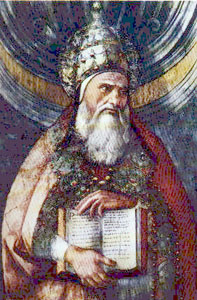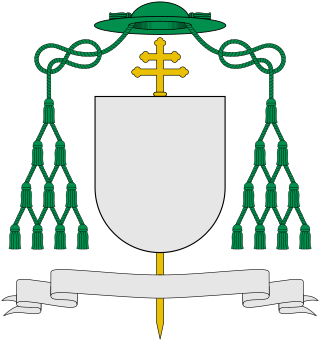Related Research Articles
An antipope is a person who claims to be Bishop of Rome and leader of the Roman Catholic Church in opposition to the legitimately elected pope. Between the 3rd and mid-15th centuries, antipopes were supported by factions within the Church itself and secular rulers.

The Holy See, also called the See of Rome, Petrine See or Apostolic See, is the central governing body of the Catholic Church and the Vatican City State. It encompasses the office of the pope as the bishop of the Apostolic episcopal see of Rome and serves as the spiritual and administrative authority of the worldwide Catholic Church and the city-state. Under international law, the Holy See holds the status of a sovereign juridical entity.

The pope is the bishop of Rome and the visible head of the worldwide Catholic Church. He is also known as the supreme pontiff, Roman pontiff, or sovereign pontiff. From the eighth century until 1870, the pope was the sovereign or head of state of the Papal States, and since 1929 of the much smaller Vatican City state. From a Catholic viewpoint, the primacy of the bishop of Rome is largely derived from his role as the apostolic successor to Saint Peter, to whom primacy was conferred by Jesus, who gave Peter the Keys of Heaven and the powers of "binding and loosing", naming him as the "rock" upon which the Church would be built. The reigning pope is Francis, who was elected on 13 March 2013.

Pius I was the bishop of Rome from c. 140 to his death c. 154, according to the Annuario Pontificio. His dates are listed as 142 or 146 to 157 or 161, respectively. He is considered to have opposed both the Valentinians and Gnostics during his papacy. He is considered a saint by the Catholic Church with a feast day in 11 July, but it is unclear if he died as a martyr.

Pope Gregory XII, born Angelo Corraro, Corario, or Correr, was head of the Catholic Church from 30 November 1406 to 4 July 1415. Reigning during the Western Schism, he was opposed by the Avignon claimant Benedict XIII and the Pisan claimants Alexander V and John XXIII. Gregory XII wanted to unify the Church and voluntarily resigned in 1415 to end the schism.
The Roman Curia comprises the administrative institutions of the Holy See and the central body through which the affairs of the Catholic Church are conducted. The Roman Curia is the institution which the Roman Pontiff ordinarily makes use of in the exercise of his supreme pastoral office and universal mission in the world: thus curialism refers traditionally to an emphasis on the supreme authority of the Holy See within the Catholic Church. It is at the service of the Pope and bishops, fulfilling their function with an evangelical spirit, working for the good and at the service of communion, unity and edification of the Universal Church and attending to the demands of the world in which the Church is called to fulfill its duty and mission.

Vatican City, officially the Vatican City State, is a landlocked sovereign country, city-state, microstate, and enclave surrounded by, and historically a part of, Rome, Italy. It became independent from Italy in 1929 with the Lateran Treaty, and is a distinct territory under "full ownership, exclusive dominion, and sovereign authority and jurisdiction" of the Holy See, which is itself a sovereign entity under international law, maintaining the city-state's temporal power, governance, diplomatic, and spiritual independence. The Vatican is also a metonym for the pope, the Holy See, and the Roman Curia.

The Papal States, officially the State of the Church, were a conglomeration of territories on the Italian peninsula under the direct sovereign rule of the Pope from 756 to 1870. They were among the major states of Italy from the 8th century until the unification of Italy, which took place between 1859 and 1870, and culminated in their demise.

The Institute for the Works of Religion, commonly known as the Vatican Bank, is a financial institution that is situated inside Vatican City and run by a Board of Superintendence, which reports to a Commission of Cardinals and the Pope. It is not a private bank, as there are no owners or shareholders; it has been established in the form of a juridical canonical foundation, pursuant to its statutes. Since 9 July 2014, its president is Jean-Baptiste de Franssu. The IOR is regulated by the Vatican's financial supervisory body ASIF.

The Archdiocese of Tunis is a Latin Church ecclesiastical territory or diocese of the Catholic Church in Tunis, Tunisia. It was founded on 10 November 1884 under the name "Archdiocese of Carthage", with territory corresponding to that of the then French protectorate of Tunisia. On 9 July 1964, it became a territorial prelature under the ecclesiastical title of Prelature of Tunis. It was made a diocese, keeping the name of Tunis, on 31 May 1995, and raised to the rank of archdiocese on 22 May 2010.
The papal household or pontifical household, called until 1968 the Papal Court, consists of dignitaries who assist the pope in carrying out particular ceremonies of either a religious or a civil character.

The Annuario Pontificio is the annual directory of the Holy See of the Catholic Church. It lists the popes in chronological order and all officials of the Holy See's departments. It also provides names and contact information for all cardinals and bishops, the dioceses, the departments of the Roman Curia, the Holy See's diplomatic missions abroad, the embassies accredited to the Holy See, the headquarters of religious institutes, certain academic institutions, and other similar information. The index includes, along with all the names in the body of the book, those of all priests who have been granted the title of "Monsignor".
The Prefecture of the Papal Household is the office in charge of the Papal Household, a section of the Roman Curia that comprises the Papal Chapel and the Papal Family.
The Special Administration of the Holy See was a dicastery of the Roman Curia from 1929 to 1967. It was established by Pope Pius XI on 7 June 1929 to manage the ₤750 million in cash and 1,000 million in Italian government bonds transferred to the Holy See in implementation of the Financial Convention attached to the Lateran Treaty of 1929.
The Prefecture for the Economic Affairs of the Holy See was an office of the Roman Curia, erected on 15 August 1967, and entrusted with overseeing all the offices of the Holy See that manage finances, regardless of their degree of autonomy.
The Administration of the Patrimony of the Apostolic See is the office of the Roman Curia that deals with the "provisions owned by the Holy See in order to provide the funds necessary for the Roman Curia to function". It was established by Pope Paul VI on 15 August 1967 and reorganized on 8 July 2014. APSA acts as the treasury and central bank of Vatican City and the Holy See.

James Patrick Green is an American prelate of the Roman Catholic Church who from 2006 to 2022 served as apostolic nuncio to a variety of countries including to several Scandinavian countries from 2017 to 2022.
The Ordinariate for Armenian Catholics of Romania, based in Gherla, is an ordinariate for Eastern Catholic faithful that is part of the Armenian Catholic Church, itself under the authority of the Pope. It serves Catholic members of Romania's Armenian community living in Transylvania.

The Diocese of Rome, also called the Vicariate of Rome, is a Latin diocese of the Catholic Church under the direct jurisdiction of the Pope, who is Bishop of Rome and hence the supreme pontiff and head of the worldwide Catholic Church. As the Holy See, the papacy is a sovereign entity with diplomatic relations, and civil jurisdiction over the Vatican City State located geographically within Rome. The Diocese of Rome is the metropolitan diocese of the province of Rome, an ecclesiastical province in Italy. According to Catholic tradition, the first bishop of Rome was Saint Peter in the first century. The incumbent since 13 March 2013 is Pope Francis.
References
- ↑ Annuario Pontificio 2012 ( ISBN 978-88-209-8722-0), p. 1847
- ↑ Phillipe Levillain. 2002. The Papacy: An Encyclopedia. p. 10; Annuario Pontificio 2012, p. 1846